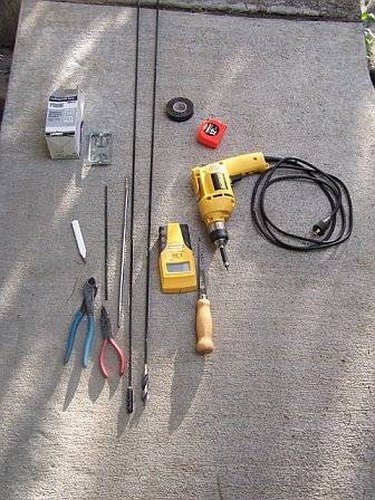Things You'll Need
Electrician's fish tape or stiff steel wire
Straightened out hangers with a hook on the end (for short applications)
Electrical tape
Flashlight
Drill (electric or 18- to 24-volt battery)
Spade or auger bits (three-eighths inch to 1 inch)
Extra long drill bits
Electrical boxes or low-voltage rings
Wire or cable
Keyhole saw or a sharp sheetrock knife
Straight edge at least 6 inches in length
Pencil
Stud finder
Cover plates, receptacles and connectors as required
Dust mask, disposable coveralls and a head-mounted flashlight, if working in an attic
A helper, to keep you from running back and forth.
Heavy duty twine

Running wire through a wall is a complex operation. If you aren't familiar with construction or what lies behind sheetrock, you might want to hire an experienced electrician. Is there an attic or a crawl space where you can run wires? Is this an exterior wall? Is there any plumbing or existing wiring in the wall where you plan to run the wire?
Step 1
Verify that there are no plumbing pipes or wires in the area where you will be cutting into the wall.
Video of the Day
Step 2
Using the template provided with the electrical box or the low voltage frame, mark the hole to be cut.
Step 3
Double check with a stud sensor to make sure there is no stud in the way of the hole to be cut.
Step 4
Cut the hole.
Step 5
Leave an assistant at the hole in the wall while you go into the attic.
Step 6
Drill a hole right above your desired location in the 2X4 header at the top of the wall from the attic. If you need to get past fire blocking further down then use a long drill bit to drill through that also.
Step 7
Run a fish tape through the holes just drilled. Alternatively, long drill bits often have a hole next to the tip that can be used to pull a wire or string back with the drill bit.
Step 8
Have your assistant pull the end of the fish tape out of the wall and attach the wire.
Step 9
Your assistant should tape over the wire at the attachment point to keep it from coming loose and to smooth out the leading edge of the wire that might otherwise snag or get caught in the hole or the wall.
Step 10
Pull on the fish tape from the attic as your partner feeds the wire or cable. Pull enough wire to reach the desired location at the other end of the cable.
Step 11
Run the fish tape down at the other end of the wire run like was done above.
Step 12
Connect a heavy twine or baling wire to the end of the fish tape and pull that into the wall where your wire or cable will go.
Step 13
Connect the heavy twine or baling wire to the cable you are installing.
Step 14
Pull on the lower end of the twine or baling wire as you feed the cable into the wall.
Step 15
You should how have a cable hanging out of the wall at least 8 inches at either end. Make whatever connections are needed for your purpose.
Tip
Avoid exterior walls. Exterior walls are much more difficult to work with. Insulation in the wall will wrap itself around drill bits and makes it hard to fish a line through. Most often the roof comes down to the point where there are only a few inches of clearance in the attic above exterior walls. If this is the case, realize that you are going to have to lay face down in the attic insulation reaching as far as you can to reach the wall while roof nails are trying to rip your scalp apart. The low clearance makes it difficult to drill through the top of the wall from above, so you will need a long drill bit designed for drilling this type of hole from below (remember the insulation will wrap itself around this drill bit and make it very difficult to remove from the wall when you are done). Check other side of wall to ensure there is no plumbing or other electrical wires or connections. All homes newer than about 1970 have fire blocking just above switch height that makes it difficult to run up or down past that point. If you are running wires where you need to get through fire blocking you have two options: use a very long drill bit to drill through it, or find an existing hole that you can use. Existing holes will be present when wires or plumbing run through the fire blocking, and sometimes there is enough room left to run additional wires through that hole. If there is a sink, tub or other plumbing on the other side of the wall, you will have to be careful not to cut or drill into those lines. Many stud finders have a feature that lets you check for wiring in the wall. Existing wiring or plumbing does not mean you cannot run your wire there, but they do mean you need to be cautious. They also mean you have to find a place for any electrical box you are installing that will not be blocked by the existing plumbing or wiring.
Warning
Never work with live electricity. Turn off power and verify that voltage has been removed. When working in the attic, stay on the trusses. The sheetrock between the boards will not hold your weight.
Video of the Day